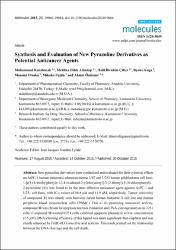Synthesis and Evaluation of New Pyrazoline Derivatives as Potential Anticancer Agents

Göster/
Erişim
info:eu-repo/semantics/openAccessTarih
2015Yazar
Karabacak, MuhammedAltıntop, Mehlika Dilek
Çiftçi, Halil İbrahim
Koga, Ryoko
Otsuka, Masami
Fujita, Mikako
Özdemir, Ahmet
Üst veri
Tüm öğe kaydını gösterÖzet
New pyrazoline derivatives were synthesized and evaluated for their cytotoxic effects on AsPC-1 human pancreatic adenocarcinoma, U87 and U251 human glioblastoma cell lines. 1-[((5-(4-Methylphenyl)-1,3,4-oxadiazol-2-yl)thio)acetyl]-3-(2-thienyl)-5-(4-chlorophenyl)-2-pyrazoline (11) was found to be the most effective anticancer agent against AsPC-1 and U251 cell lines, with IC50 values of 16.8 mu M and 11.9 mu M, respectively. Tumor selectivity of compound 11 was clearly seen between Jurkat human leukemic T-cell line and human peripheral blood mononuclear cells (PBMC). Due to its promising anticancer activity, compound 11 was chosen for apoptosis/necrosis evaluation and DNA-cleavage analysis in U251 cells. Compound 11-treated U251 cells exhibited apoptotic phenotype at low concentration (1.5 mu M). DNA-cleaving efficiency of this ligand was more significant than cisplatin and was clearly enhanced by Fe(II)-H2O2-ascorbic acid systems. This result pointed out the relationship between the DNA cleavage and the cell death.

















